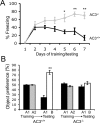The type 3 adenylyl cyclase is required for novel object learning and extinction of contextual memory: role of cAMP signaling in primary cilia
- PMID: 21490195
- PMCID: PMC3091825
- DOI: 10.1523/JNEUROSCI.6561-10.2011
The type 3 adenylyl cyclase is required for novel object learning and extinction of contextual memory: role of cAMP signaling in primary cilia
Abstract
Although primary cilia are found on neurons throughout the brain, their physiological function remains elusive. Human ciliopathies are associated with cognition defects, and transgenic mice lacking proteins expressed in primary cilia exhibit defects in learning and memory. Recently, it was reported that mice lacking the G-protein-coupling receptor somatostatin receptor-3 (SSTR3), a protein expressed predominately in the primary cilia of neurons, have defective memory for novel object recognition and lower cAMP levels in the brain. Since SSTR3 is coupled to regulation of adenylyl cyclase, this suggests that adenylyl cyclase activity in primary cilia of CNS neurons may be critical for some forms of learning and memory. Because the type 3 adenylyl cyclase (AC3) is expressed in primary cilia of hippocampal neurons, we examined AC3(-/-) mice for several forms of learning and memory. Here, we report that AC3(-/-) mice show no short-term memory for novel objects and fail to exhibit extinction of contextual fear conditioning. They also show impaired learning and memory for temporally dissociative passive avoidance. Since AC3 is exclusively expressed in primary cilia, we conclude that cAMP signals generated within primary cilia contribute to some forms of learning and memory, including extinction of contextual fear conditioning.
Figures




Similar articles
-
Somatostatin signaling in neuronal cilia is critical for object recognition memory.J Neurosci. 2010 Mar 24;30(12):4306-14. doi: 10.1523/JNEUROSCI.5295-09.2010. J Neurosci. 2010. PMID: 20335466 Free PMC article.
-
Type 1 adenylyl cyclase is essential for maintenance of remote contextual fear memory.J Neurosci. 2008 Nov 26;28(48):12864-7. doi: 10.1523/JNEUROSCI.2413-08.2008. J Neurosci. 2008. PMID: 19036980 Free PMC article.
-
Ca-stimulated type 8 adenylyl cyclase is required for rapid acquisition of novel spatial information and for working/episodic-like memory.J Neurosci. 2008 Apr 30;28(18):4736-44. doi: 10.1523/JNEUROSCI.1177-08.2008. J Neurosci. 2008. PMID: 18448650 Free PMC article.
-
The role of Ca2+/calmodulin-stimulable adenylyl cyclases as molecular coincidence detectors in memory formation.Cell Mol Life Sci. 1999 Apr;55(4):525-33. doi: 10.1007/s000180050311. Cell Mol Life Sci. 1999. PMID: 10357223 Free PMC article. Review.
-
Calmodulin-regulated adenylyl cyclases and neuromodulation.Curr Opin Neurobiol. 1997 Jun;7(3):391-6. doi: 10.1016/s0959-4388(97)80068-2. Curr Opin Neurobiol. 1997. PMID: 9232797 Review.
Cited by
-
Heteromerization of ciliary G protein-coupled receptors in the mouse brain.PLoS One. 2012;7(9):e46304. doi: 10.1371/journal.pone.0046304. Epub 2012 Sep 27. PLoS One. 2012. PMID: 23029470 Free PMC article.
-
Mechanisms of Weight Control by Primary Cilia.Mol Cells. 2022 Apr 30;45(4):169-176. doi: 10.14348/molcells.2022.2046. Mol Cells. 2022. PMID: 35387896 Free PMC article. Review.
-
Neuronal and astrocytic primary cilia in the mature brain.Pharmacol Res. 2018 Nov;137:114-121. doi: 10.1016/j.phrs.2018.10.002. Epub 2018 Oct 4. Pharmacol Res. 2018. PMID: 30291873 Free PMC article. Review.
-
Primary Cilia Dysfunction in Neurodevelopmental Disorders beyond Ciliopathies.J Dev Biol. 2022 Dec 13;10(4):54. doi: 10.3390/jdb10040054. J Dev Biol. 2022. PMID: 36547476 Free PMC article. Review.
-
Ca2+-stimulated adenylyl cyclases as therapeutic targets for psychiatric and neurodevelopmental disorders.Front Pharmacol. 2022 Sep 16;13:949384. doi: 10.3389/fphar.2022.949384. eCollection 2022. Front Pharmacol. 2022. PMID: 36188604 Free PMC article. Review.
References
-
- Abel T, Nguyen PV, Barad M, Deuel TA, Kandel ER, Bourtchouladze R. Genetic demonstration of a role for PKA in the late phase of LTP and in hippocampus-based long-term memory. Cell. 1997;88:615–626. - PubMed
-
- Adamantidis A, Thomas E, Foidart A, Tyhon A, Coumans B, Minet A, Tirelli E, Seutin V, Grisar T, Lakaye B. Disrupting the melanin-concentrating hormone receptor 1 in mice leads to cognitive deficits and alterations of NMDA receptor function. Eur J Neurosci. 2005;21:2837–2844. - PubMed
-
- Berbari NF, Bishop GA, Askwith CC, Lewis JS, Mykytyn K. Hippocampal neurons possess primary cilia in culture. J Neurosci Res. 2007;85:1095–1100. - PubMed
-
- Bishop GA, Berbari NF, Lewis J, Mykytyn K. Type III adenylyl cyclase localizes to primary cilia throughout the adult mouse brain. J Comp Neurol. 2007;505:562–571. - PubMed
Publication types
MeSH terms
Substances
Grants and funding
LinkOut - more resources
Full Text Sources
Other Literature Sources
Medical
Molecular Biology Databases
